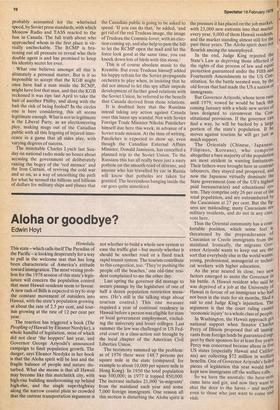Aloha or goodbye?
Edwin Hoyt
Honolulu This state —which calls itself The Paradise of the Pacific — is looking desperately for a way to pull in the welcome mat that has long been characteristic of America's attitude toward immigration. The most vexing problem for the 1978 session of this state's legislature will concern the population control that most Hawaii residents seem to favour. A new rash of Bills is expected to try to stop the constant movement of outsiders into Hawaii, with the state's population growing at about the rate of 2.5 per cent, and tourism growing at the rate of 12 per cent per year.
The reaction has triggered a book (The Peopling of Hawaii by Eleanor Nordyke), a Whole handful of legislation, most of which did not clear 'the hoppers' last year, and Governor George Ariyoshi's announced campaign to limit population growth. The danger, says Eleanor Nordyke in her book is that the Aloha spirit will be lost and the fragile balance of people and nature disturbed. What she means is that all Hawaii may become like this matchstick city, with high-rise building mushrooming up behind high-rise, and the single superhighway along the narrow coastal plain so crowded that the current transportation argument is not whether to build a whole new system to ease the traffic glut — but merely whether it should be another road or a fixed track rapid transit system. The tourists contribute to this congestion, too. 'They're pushing the people off the beaches,' one old-time resident complained to me the other day.
Last spring the governor did manage to secure passage by the legislature of one of half a dozen population restriction measures. (He's still in the talking stage about tourism control.) This one measure required a year of continual residency in Hawaii before a person was eligible for state or local government employment, excluding the university and lesser colleges. Last summer the law was challenged in US Federal court in a class-action suit brought by the local chapter of the American Civil Liberties Union.
The testimony summed up the problem: as of 1976 there were 148.7 persons per square mile in the state (compared, for example to about 10,000 per square mile in Hong Kong). In 1950 the total population was 500,000; in 1977 it topped 850,000. The increase includes 21,000 'in-migrants' from the mainland each year and some 7,000 foreign immigrants. One reason all this motion is disturbing the Aloha spirit is
the pressure it has placed on the job market, with 23,000 new entrants into that market every year, 9,000 of them Hawaii residents, and the market standing almost still for the past three years. The Aloha spirit does not flourish among the unemployed.
In the end, Judge King rejected the State's Law as depriving those affected of the rights of due process of law and equal protection guaranteed under the Fifth an° Fourteenth Amendments to the US Con' stitution. So the battle seemed won, by the old forces that had made the US a nation of immigrants. But Governor Ariyoshi, whose term rills until 1979, vowed he would be back this coming January with a whole new series of laws designed to circumvent the Constitutional provisions. If the governor .can find a way, he will be backed by a large portion of the state's population. If he moves against tourism he will get just as much support.
The Orientals (Chinese, Japanese, Filipinos, Koreans), who comprise altogether a bare majority of the population are most strident in wanting limitations. Their fathers were brought here as contract labourers, they stayed and prospered, and now the Japanese virtually dominate the State government (one of the US's highest paid bureaucracies) and educational sys• tern. They comprise only 26 per cent of the total population, and are outnumbered IV the Caucasians at 27 per cent. But the fig' ures are misleading; many Caucasians are military residents, and do not in any case, vote here.
Thus the Oriental community has a coifl. fortable position, which some feel Is threatened by the preponderance of Caucasian or Creole immigrants from the mainland. Ironically, the migrants Governor Ariyoshi wants to keep out are the sort that everybody else in the world wants.: young, professional, managerial or techlw cal workers with higher education,
As the year neared its close, two new factors emerged to assist the Governor in his battle. A Hawaii resident who said he was deprived of a job at the University of Hawaii in favour of an immigrant who had not been in the state for six months, filed a suit to end Judge King's injunction. The argument is that the court ruling causes 'economic injury' to a whole class of people' In Washington, the Hawaii approach got national support when Senator Charles Percy of Illinois proposed that all immit'
rants from foreign lands be guaranteed sup
port by their sponsors for at least five years' Percy was concerned because aliens in five
US states (especially Hawaii and Califo(nia) are collecting $72 million in welfare benefits. One of Governor Ariyoshi's failed pieces of legislation this year would have kept new immigrants off the welfare rolls.
So we have the anomaly: the have-nots came here and got, and now they want t°
• shut the door to the haves — and maybe., even to those who just want to come and visit.


































 Previous page
Previous page